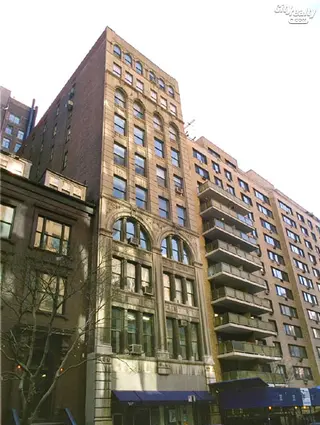 Carter Horsley
Carter HorsleyJan 30, 2020
Carter's Review
This 10-story, neo-Renaissance-style store and loft building at 4 West 16th Street between Fifth and Sixth Avenues was erected in 1902 by Richard J. Leary and has 16 co-operative apartments.
It was designed by John W. Stevens.
Long occupied by various manufacturing companies, by 1934 its principal tenant was
Robert M. McBride & Company, Publishers, and the building was long known as the McBride building. Most recently, it has been converted largely to residential use. The building replaced a three-story house which faced West 16th Street and a stable structure with living quarters at the rear of the lot.
It was converted to a co-operative in 1980.
Bottom Line
A handsome, 1902, neo-Renaissance building that was converted to a co-operative in 1980 and is distinguished by its rustication and two large arches of window on the fifth floor and its smaller arched windows on the 8th and 10th floors.
Description
The designation report for the Ladies' Mile Historic District provides this description of the building:
"Thirty-five feet wide, the façade is clad in limestone and organized in a stacked composition of one, three, four, and two stories. Windows are double-hung with wood frames and sash except on the third, sixth, seventh and ninth floors which have been replaced with aluminum. The base, originally with three rusticated piers, has been altered. A modern storefront replaces the central pier.
"The second tier, the most richly ornamented, is a three-story, two-bay arcade with fluted pilasters, egg and dart moldings in the arches, keystones, and arch spandrels embellished with foliate designs. Recessed floor spandrels are simply paneled and tripartite windows are subdivided by square colonettes.
"The third tier is a four-story arcade with scored piers and arches with keystones. The arch spandrels are unembellished and the simple floor spandrels are recessed.
"The fourth tier is two stories, each with two groups of three windows. The lower story windows are rectangular; the upper story is a simple arcade with a molding at the impost. The cornice which once crowned this tier has been removed."
Amenities
The building has an intercom, a bicycle room, basement storage, a live-in superintendent, a laundry room and a key-locked elevator.
Apartments
Some apartments have barrel-vaulted ceilings.
A January 6, 2020 article at 6sqft.com provided the following perspective on barrel vaults:
'The majority of New York City's loft buildings were once manufacturing and storage hubs that had to support the heavy loads of the industry/machines they hosted. Rather than use enormous beams and a forest of columns for structural support, barrel-vaulted ceilings provided a more efficient means to distribute gravity loads without cluttering the spaces with columns.
"There is no one set classification for barrel-vaulted ceilings, but New York real estate defines them as vaulted ceilings with an arch and ribs serving as support. It turns out the construction method results in in some unexpected soundproofing, and now with many industrial spaces turned residences, acoustic insulation is undoubtedly a useful perk in NYC....
"Barrel-vaulted homes typically come with loftier ceiling heights and open layouts, which let in more natural light. The vaults can be coated in light-reflecting paint or the brick portions can be left exposed. One negative aspect is that high-ceiled spaces require higher energy demands to keep the air temperate. Nevertheless, if one can overlook this caveat and the cost of buying such an apartment (a type often found in the city's most desirable neighborhoods), one can truly appreciate the character and wow factor these ceilings add to any space."

- Co-op built in 1902
- Located in Flatiron/Union Square
- 16 total apartments 16 total apartments
- 10 recent sales ($1.3M to $4.2M)
- Pets Allowed
 6sqft delivers the latest on real estate, architecture, and design, straight from New York City.
6sqft delivers the latest on real estate, architecture, and design, straight from New York City.
